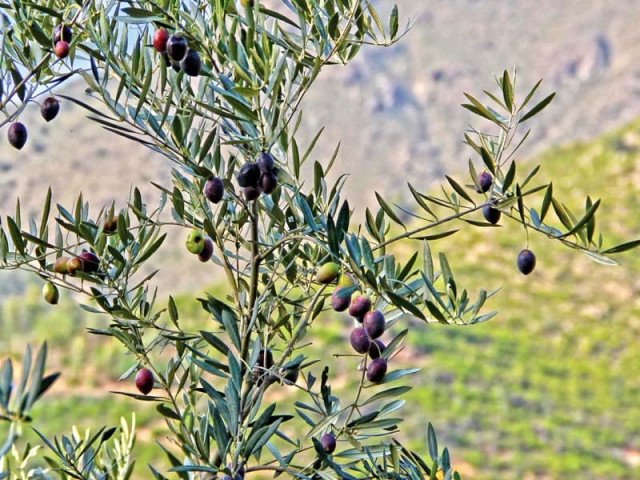Empowering local communities: Olive trees spell greener days for Lower Dir’s farmers
With training in grafting and fruit processing, locals anticipate a thriving industry in the future.

Olive trees in Talaash, Lower Dir where local farmers process the fruit to make an income out of it. PHOTO: FAZAL KHALIQ/EXPRESS
With soil and climate highly-favourable for the olive tree, Lower Dir is home to millions of wild olive trees which bear no fruit and are thus extensively used for fuel. Agriculturists believe converting the wild trees into fruit-bearing ones can radically change the lives of locals and generate significant revenue for the country.
With this aim, the four-year Programme for Economic Advancement and Community Empowerment (PEACE), funded by the European Union and implemented by the Sarhad Rural Support Programme, was launched in 2013 in all districts of Malakand Division—Swat, Shangla, Buner, Lower Dir, Upper Dir, Chitral and Malakand Agency.
Under the project, local farmers were trained in converting wild olive trees into fruit-bearing ones, proper fruit processing and strategies to make their olive businesses profitable.
To date, the project has benefited hundreds of people. Local farmers say they were aware of the benefits of olives, but did not know the proper method of converting wild trees into productive ones and ways of processing the fruit.

“There are millions of wild olive trees in this region. We thought they were of no use except wood for fuel because we were not aware of the plant’s financial benefits,” said Zafar Ali, a resident of Amluk Dara Talaash, who has converted 300 wild olive trees and planted 400 new ones in his farm with the help of the PEACE programme.
“Now, we know the monetary benefits of olive trees and have been trained in the technicalities of wild tree grafting and proper tree management. In the next five years, Dir district will have a thriving olive industry,” he said.
Muhammad Israr is a Dheria Talaash native who has more than 10,000 olive trees of which 4,000 are in the bearing stage and produce 12 tonnes of fruit annually. “We used to employ traditional methods earlier and would lose much of the fruit during the harvest, however, after getting training we have learnt to process the fruit properly. This has minimised our losses and increased income,” he said.
According to the programme’s official, Amjad Ali, locals have been trained in how to add value to raw olives through advanced technologies of preservation and olive product development. Moreover, owners of olive trees in Lower Dir are now organised under the Business Interest Group and can reap benefits from the olive market.

According to Falak Naz Shah, the head of Agriculture Research Institute (ARI) Tarnab’s food technology department, there are 80 million wild olive trees in Malakand and 18,000 of them have been turned productive through grafting.
He said farmers should be assisted by not just training but also by the provision of relevant tools and equipment, storage facilities and preservatives. “If the millions of wild trees are converted into fruit-producing ones, and the product processed and packaged properly, billions of rupees can be generated for the country,” he said.
Published in The Express Tribune, March 31st, 2015.
An earlier version of this story incorrectly stated the SRSP was jointly funding PEACE. The error is regretted.













COMMENTS
Comments are moderated and generally will be posted if they are on-topic and not abusive.
For more information, please see our Comments FAQ